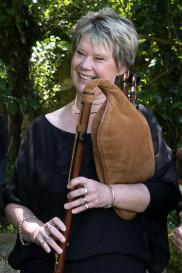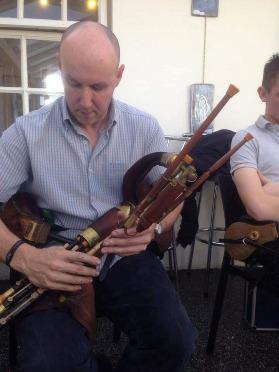The Bagpipe Society
Grace Notes

Membership of the Society slowly creeps up year on year and the new joiners always outweigh the non-renewals. I often wonder what makes someone join The Bagpipe Society and I like to think that for many, the impetus for joining is to have four journals a year pop through their letterbox. In my role as editor of Chanter, I aim to meet the aims of the Society by publishing articles informing on the diversity of bagpipes and their social and cultural history and encouraging research into all aspects of piping.
Occasionally, I am able to share tunes and techniques (more submissions please!) and from time to time I carry a feature on makers’ techniques and processes which hopefully inspires others to experiment with making.
As well as Chanter and the Blowout, the other main tool the Society has is its website. It gets a certain amount of ‘traffic’ but I sometimes wonder how many members use the resources that are available within it. I often use it to search out an old article from Chanter as it’s far easier going to the website than leafing through the copies on my bookshelf and I suspect I’m not the only one doing this. But there is also a large section, accessible by members only, which contains various resources including many plans and designs of bagpipes of all sorts, together with research, music and documents. I suspect this Members area is very little used. Material is being added over time and, later in this edition, Ian Clabburn writes more on what can be found there. Hopefully, the bagpipe plans and drawings will encourage more people to make bagpipes.
But the world of instrument making is changing all the time and 3D printing is now a firmly established technology which is becoming more and more refined. You may remember that Donald Lindsay wrote about his work a few years ago and in this edition, a new maker, Cam St Louis, tells us about his 3D journey.
Another way the Society meets its aims is to encourage new players of the instrument and we do this by having a number of bagpipes which are used at various events for ‘have a go’ sessions. Since June, these pipes have been at Halsway Manor, Loxwood Joust, Medieval Music in the Dales and the Birmingham Conservatoire. At each event, there is always at least one person (usually more) whose eyes light up and their smile broadens and we know that a new convert has joined the ranks! But buying a set can be a difficult next step. So, for this reason, the Society has established a loan scheme for the pipes. There are various caveats (such as making sure they are available for some flagship events throughout the year) and the conditions for loans can be found in the Members area.

Speaking of student pipes…. Halsway Manor in Somerset is hosting the annual Hurdy Gurdy and Bagpipe weekend from 18‑20th February (with David Faulkner and Andrea Hotzko), followed straight afterwards by the PIVA Real Roots! course (myself and Jude Rees). So, play modern Euro dance music at the weekend and then delve back into history and play its earlier roots through the week. Perfect! The student pipes will be available for both events. Further details from https://halswaymanor.org.uk/
I am delighted to make this something of an ‘Eric Montbel Special’! Eric has, over the years, had a significant influence on bagpipes and piping, not only in France playing traditional music but because of his love of research, jazz, experimentation and broad musical horizons it’s meant that he has had a major impact in many fields and in many countries. Thank you Eric!
This has been a bumper year for Chanter and every edition, including this one, has run over its normal size. Articles which were planned for the History Special had to be held over but I am pleased to print them now. A fascinating and thought-provoking paper by Bill Lyons on bagpipes in historical performance and a study on little known bagpipe iconography in Mexico by José Benito Nava Monroy.
Finally, don’t forget to put a date in your diaries for the IBO Conference being held in Newcastle, in association with the NPS on 11-13 March. See you there!

Hi Jane, With regards to the picture of the Uilleann piper from the Ashmolean Museum collection featured on the rear cover of the last edition, it had an odd looking pipe sticking up in totally the wrong direction. Maybe the attached photo answers the questions raised by that picture…. Regards, Dave Rowlands
Dear Jane Chrisoph Heyl, in his article on pastoral pipes, attributes “Ravenscroft’s Fancy” in Geoghegan’s Tutor to the early 17th century by Thomas Ravenscroft. However, in style and date it would surely be John Ravenscroft, musician and fiddler in the first half of the eighteenth century, wait of Tower Hamlets and leader of the orchestra at Goodman’s Fields Theatre. Regards, Alan Radford
By José Benito Nava Monroy Moulder, Jane Trad Various
From Chanter Winter 2021.
- Data Processing Notice (GDPR)
-
@BagpipeSociety on X (formally known as Twitter)
-
TheBagpipeSociety on Instagram
-
 BagpipeSociety on Facebook
BagpipeSociety on Facebook
Something wrong or missing from this page? Let us know!
